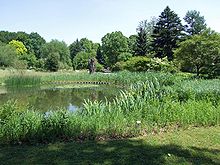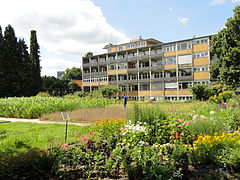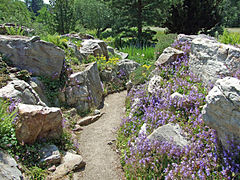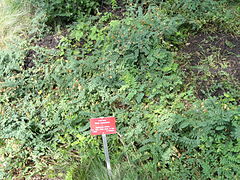Botanical Garden Frankfurt am Main
Today's Botanical Garden Frankfurt am Main belonged to the Goethe University Frankfurt until the end of 2011 and has been owned by the City of Frankfurt ever since . The garden was from 1763 to 1774 by that of Johann Christian Senckenberg built Dr. Senckenberg Foundation established. First it was created southeast of the Eschenheimer Tower with a size of about one hectare between today's Bleichstrasse and Stiftstrasse. Senckenberg, together with the first abbey botanist Johann Heinrich Bäumerth , planned the Frankfurt Botanical Garden based on the model of the garden established by Carl von Linné in Uppsala , but never saw its completion.
The intention of the founder was to have an area for the cultivation of medicinal medicinal plants, a pharmacist's garden, set up in the immediate vicinity of the community hospital, which he also donated .
First garden
Because of the thematic focus on medicinal plants , physicians ( medical doctors ) were always appointed to head the garden - with the help of trained gardeners - until 1867 , and botanists only afterwards . Increasing loss of area through development and the also increased air pollution made a move necessary at the end of the 19th century.
Second garden
After long negotiations between the city and the foundation, a 1.4 hectare site east of the palm garden was found and made available. The move took place between 1907 and 1908. The transplantation of made Senckenberg yew , a then about three hundred years old yew tree , a big stir. At that time, the director was Martin Möbius, in collaboration with the head gardener Rudolph Günther . In addition to the systematic department according to Linnaeus, this garden already had a part that was built according to ecological criteria. The garden was primarily intended to serve the research of the Senckenberg Institute and subsequently the Goethe University, founded in 1914. During the 1930s, horticultural inspector Kurt Kiehne redesigned the garden. He established an arboretum and the first plant-geographical parcels ( alpine , sand dune ). When this garden became too small for research, the third, today's garden, was planned in 1930. The area of the second garden was later added to the palm garden.
Third and current garden
A new piece of land was soon found: a part of the Grüneburgpark about eight hectares in size. Thus, after six years of planning, Kurt Kiehne, who was commissioned in 1931, was able to start construction in 1937. Through his training at the Botanical Garden in Berlin-Dahlem , Kiehne was primarily interested in expanding the plant geography department with a focus on Central European vegetation. Due to the Second World War and the location of the garden in the restricted area of the American military administration, the garden could not be completed until 1958. Extensive systems show plants from southern Europe, Asia and North America in particular. Last but not least, the site now offers a valuable habitat for insects in the city.
The large buildings of the biological institutes in the entrance area of the botanical garden were built in 1954/55 by the architect and university master builder Ferdinand Kramer , the outbuildings in the early 1960s. They represent the last large and uniformly functional ensemble of Kramer's university buildings and, following a name suggested by Kramer, have been referred to as the biology campus together with the garden area since the beginning of 1997 .
Since the end of 2006 there has been discussion of merging the botanical garden with the palm garden after the biological institutes were relocated to the Riedberg campus . The fate of the buildings has not yet been decided. The Friends of the Botanical Garden of the Johann Wolfgang Goethe University, Frankfurt am Main e. V. tries to maintain the facility as an educational institution.
Although the Botanical Garden has been part of the municipal palm garden (subject to entry) since January 1, 2012, admission remains free. The garden is closed to the public from November to February.
See also
literature
- Beate Alberternst: The Botanical Garden of the JW Goethe University Frankfurt am Main - An illustrated guide . Books on Demand GmbH, Norderstedt 2005, ISBN 978-3-8334-2855-5 .
- Rüdiger Wittig (Ed.): Geobotany, species protection and diversity of collections in the botanical garden of the Johann Wolfgang Goethe University . Verlag Natur und Wissenschaft Hieronimus and Schmidt, Solingen 1997, ISBN 978-3-927889-42-2 .
Web links
- Botanical Garden Frankfurt am Main. Freundeskreis Botanischer Garten e. V., accessed on November 20, 2018 .
Individual evidence
- ↑ Hans Joachim Conert: The history of the botanical-paleobotanical department . In: Senckenbergiana Biologica . Special issue C, No. 48 . Senckenberg Research Institute and Natural History Museum Frankfurt am Maining Publishing division, Frankfurt am Main 1967, p. 5, 7 .
- ^ Günter Rosenstock: The Botanical Institute and the Botanical Garden in 1966, their buildings, operating units and open-air facilities . In: K. Egle, G. Rosenstock: The history of botany in Frankfurt am Main . Umschau Verlag , Frankfurt am Main 1966, p. 57-97 .
- ^ Ferdinand Kramer: The Biological Camp of the University of Frankfurt a. M. In: Bauwelt . No. 48 . Bauverlag BV GmbH, 1957, ISSN 0005-6855 , p. 1262-1267 .
Coordinates: 50 ° 7 ′ 38 ″ N , 8 ° 39 ′ 30 ″ E









